Related Research Articles

Tibetan Buddhism is a form of Buddhism practiced in Tibet, Bhutan and Mongolia. It also has a sizable number of adherents in the areas surrounding the Himalayas, including the Indian regions of Ladakh, Sikkim, and Arunachal Pradesh, as well as in Nepal. Smaller groups of practitioners can be found in Central Asia, Xinjiang, Inner Mongolia, and some regions of Russia, such as Tuva, Buryatia, and Kalmykia.

Padmasambhava, also known as Guru Rinpoche and the Lotus from Oḍḍiyāna, was a tantric Buddhist Vajra master from medieval India who taught Vajrayana in Tibet. According to some early Tibetan sources like the Testament of Ba, he came to Tibet in the 8th century and helped construct Samye Monastery, the first Buddhist monastery in Tibet. However, little is known about the actual historical figure other than his ties to Vajrayana and Indian Buddhism.
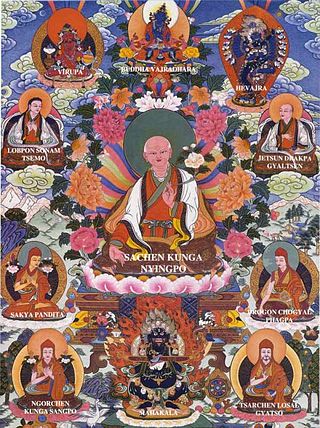
The Sakya school is one of four major schools of Tibetan Buddhism, the others being the Nyingma, Kagyu, and Gelug. It is one of the Red Hat Orders along with the Nyingma and Kagyu.

The Gelug is the newest of the four major schools of Tibetan Buddhism. It was founded by Je Tsongkhapa (1357–1419), a Tibetan philosopher, tantric yogi and lama and further expanded and developed by his disciples.

The schools of Buddhism are the various institutional and doctrinal divisions of Buddhism that have existed from ancient times up to the present. The classification and nature of various doctrinal, philosophical or cultural facets of the schools of Buddhism is vague and has been interpreted in many different ways, often due to the sheer number of different sects, subsects, movements, etc. that have made up or currently make up the whole of Buddhist traditions. The sectarian and conceptual divisions of Buddhist thought are part of the modern framework of Buddhist studies, as well as comparative religion in Asia.

The Rimé movement is a movement or tendency in Tibetan Buddhism which promotes non-sectarianism and universalism. Teachers from all branches of Tibetan Buddhism – Sakya, Kagyu, Nyingma, Jonang, Gelug, and Bon – have been involved in the promoting Rimé ideals.
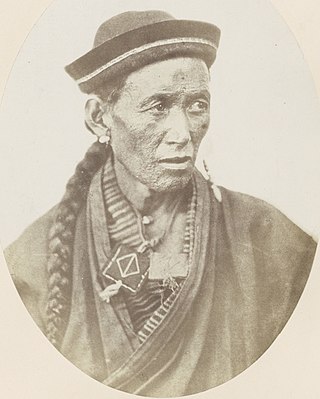
The Bhutia are a community of Sikkimese people living in the state of Sikkim in northeastern India, who speak Drenjongke or Sikkimese, a Tibetic language fairly mutually intelligible with standard Tibetan. In 2001, the Bhutia numbered around 60,300. Bhutia here refers to people of Tibetic ancestry.

Nyingma, often referred to as Ngangyur, is the oldest of the four major schools of Tibetan Buddhism. The Nyingma school is founded on the first lineages and translations of Buddhist scriptures from Sanskrit into Tibetan in the eighth century, during the reign of King Trisong Detsen.
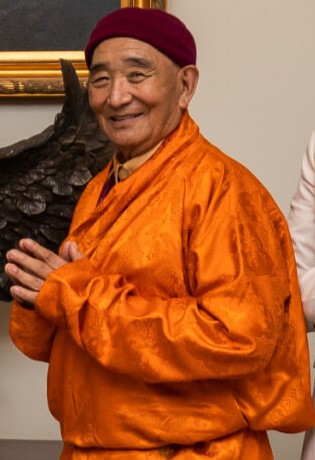
Tarthang Tulku Rinpoche is a Tibetan Vajrayana teacher and lama who introduced the Nyingma school tradition of Tibetan Buddhism to the United States. Tarthang Tulku works to preserve the buddhadharma, the art and the culture of Tibet. He oversees various projects including Dharma Publishing, Yeshe-De, Tibetan Aid Project, the annual Nyingma school Monlam Chenmo World Peace Ceremony in Bodhgaya, and the construction of the Odiyan Copper Mountain Mandala. Tarthang Tulku also introduced Kum Nye to the West.
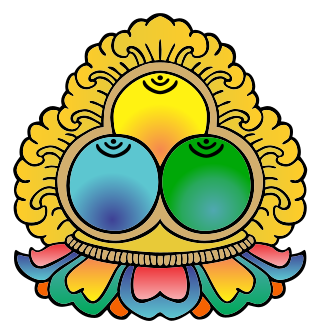
In Tibetan Buddhism, the Three Jewels and Three Roots are supports in which a Buddhist takes refuge by means of a prayer or recitation at the beginning of the day or of a practice session. The Three Jewels are the first and the Three Roots are the second set of three Tibetan Buddhist refuge formulations, the Outer, Inner and Secret forms of the Three Jewels. The 'Outer' form is the 'Triple Gem', the 'Inner' is the Three Roots and the 'Secret' form is the 'Three Bodies' or trikāya of a Buddha.

Lamaling Monastery, also known as Zangdrok Pelri Monastery and Burqug Lamaling (布久喇嘛林寺), is a Buddhist monastery located near the village of Jianqie, Burqug Township, Bayi District, in Tibet, on a small hill 1.5 km south of Buchu Monastery. The monastery belongs to the Nyingmapa sect, translated as the ‘Ancient Ones’; their lineages go back to the first infusion of Buddhism from India to Tibet in the 7th century CE. The Nyingma sect incorporated many of the traditions of the native Tibetan Bon religion, which respects nature and local nature spirits.
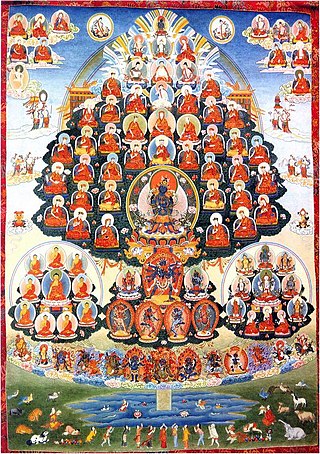
The imagery of the Refuge Tree, also referred to as Refuge Assembly, Refuge Field, Merit Field, Field of Merit or Field of Accumulation is a key part of a visualization and ngöndro practice common to Vajrayana Buddhism. Based on descriptions in the liturgical texts of various traditions, Refuge Trees are often depicted in thangkas employed as objects of veneration, mnemonic devices and as a precursor to the contents being fully visualized by the Buddhist practitioner during the Refuge Formula or evocation.

Thubten Chökyi Dorje was the 5th Dzogchen Rinpoche of Tibet in the Nyingma sect of Tibetan Buddhism.

Katok Tsewang Norbu was a teacher of the Nyingma school of Tibetan Buddhism who notably championed the shentong or "empty of other" view first popularised by the Jonang school as well as examining the Chan Buddhist teachings of Hashang Mahayana, known as Moheyan. Despite the shentong view being banned as heretical, he successfully taught and cultivated its teachings as a legitimate view among the Nyingmapa.

The main religion in Tibet has been Buddhism since its outspread in the 8th century AD. As of 2022 the historical region of Tibet is mostly comprised in the Tibet Autonomous Region (TAR) of China and partly in the Chinese provinces of Qinghai and Sichuan. Before the arrival of Buddhism, the main religion among Tibetans was an indigenous shamanic and animistic religion, Bon, which would later influence the formation of Tibetan Buddhism and still attracts the allegiance of a sizeable minority of Tibetans.

Takthok Monastery is a Buddhist monastery in Sakti village in Ladakh, northern India, located approximately 46 kilometres east of Leh. It is the only monastery in Ladakh belonging to the Nying-ma-pa or Red Hat sect. The name Takthok, literally meaning 'rock-roof' was named because both its roof as well as walls are made up of rock. It belongs to the Nyingma tradition of Tibetan Buddhism and approximately 55 lamas reside there. It is the only Nyingma monastery in Ladakh.

Kungri Monastery is a Buddhist monastery of the Nyingma sect of Tibetan Buddhism in the Pin Valley in Lahul and Spiti, Himachal Pradesh, northern India.

Dzongsar Monastery is a Buddhist monastery in Dêgê County in the Garzê Tibetan Autonomous Prefecture of Sichuan, China, southeast of the town of Derge and east of Palpung Monastery. Historically it lay in the Kham region of Tibet. It was founded in 746, destroyed in 1958, and rebuilt in 1983.
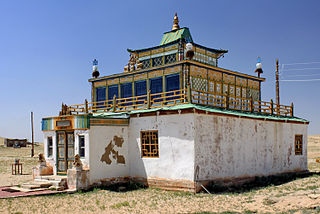
Khamar Monastery, founded in 1820, was an important Red Hat sect Buddhist monastic, cultural, and education center in Mongolia’s Gobi Desert region until its destruction in 1937. It was rebuilt in 1990. Today it is located in Khatanbulag district, Dornogovi Province, approximately 47 km south of the provincial capital Sainshand. At its height, the monastery reportedly accommodated over 80 temples and some 500 monks.
Buddhists, predominantly from India, first actively disseminated their practices in Tibet from the 6th to the 9th centuries CE. During the Era of Fragmentation, Buddhism waned in Tibet, only to rise again in the 11th century. With the Mongol invasion of Tibet and the establishment of the Mongol Yuan dynasty (1271–1368) in China, Tibetan Buddhism spread beyond Tibet to Mongolia and China. From the 14th to the 20th centuries, Tibetan Buddhism was patronized by the Chinese Ming dynasty (1368–1644) and the Manchurian Qing dynasty (1644–1912) which ruled China.
References
- ↑ Melvyn C. Goldstein (15 November 2023). A History of Modern Tibet, 1913-1951: The Demise of the Lamaist State. University of California Press. p. 1. ISBN 978-0-52-091176-5.